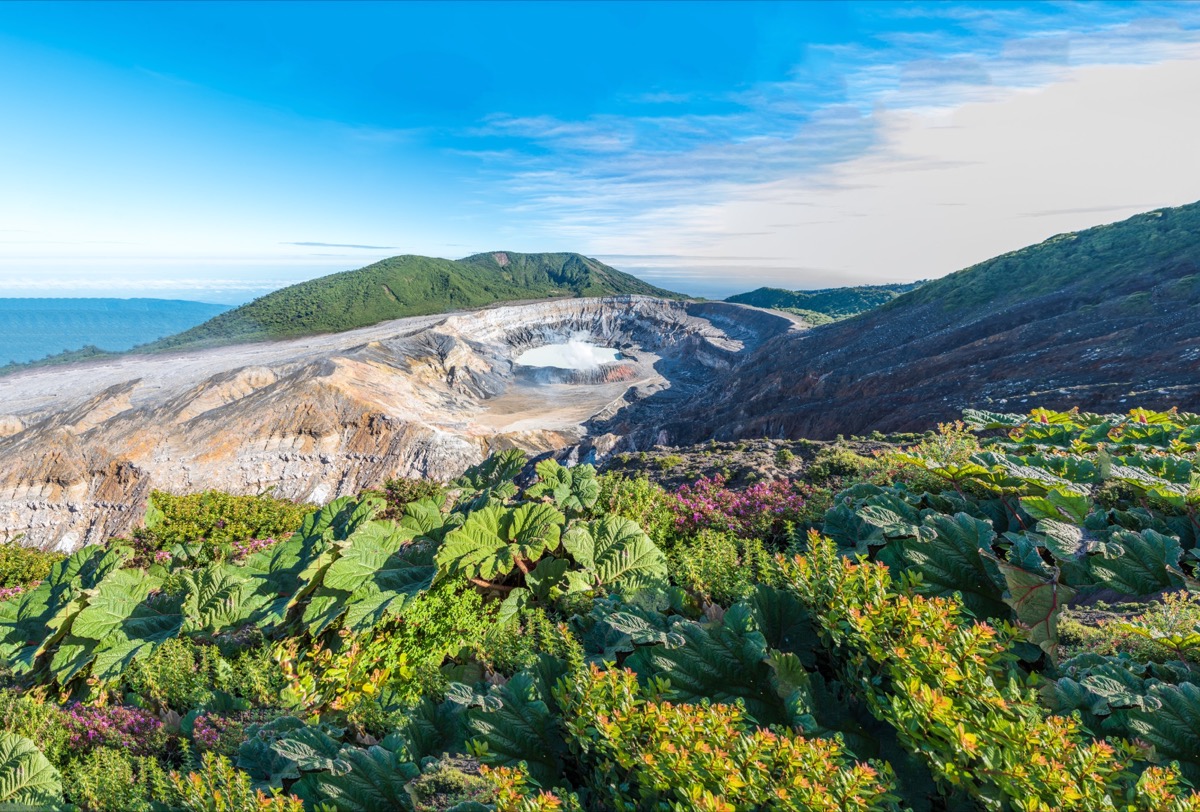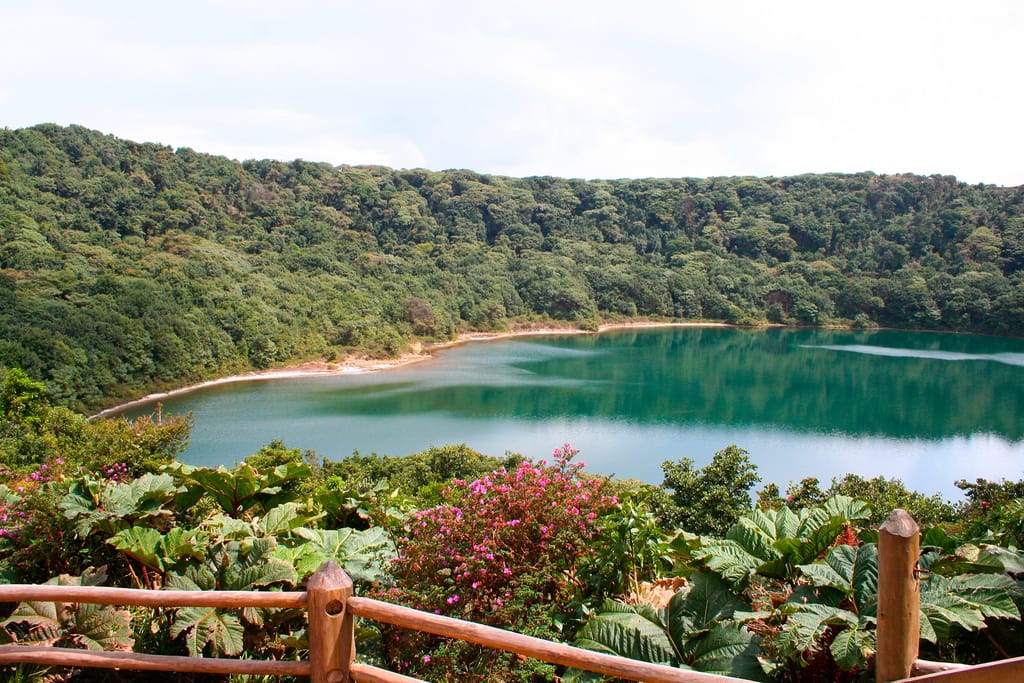Poás Volcano National Park
The geological origins of the Poás volcano
The Poás volcano, located in Costa Rica, 1:30 from the capital San José, is one of the most active and studied volcanoes in Costa Rica. Its complex geological history is marked by a series of eruptions, crater formations and geothermal phenomena.
Tectonic context
Tectonic plate
Costa Rica lies on the Caribbean tectonic plate, bordered by the Cocos Plate to the west. Subduction of the Cocos Plate beneath the Caribbean Plate is the main driver of volcanic activity in the region, including the Poas volcano.
Subduction zone
The subduction zone between the Cocos Plate and the Caribbean Plate leads to partial melting of the Earth’s mantle, generating magma that rises to the surface to form volcanoes. This process is responsible for the formation of Costa Rica’s central volcanic chain, of which the Poás volcano is a part.
The evolution of the national park over the years
Age and origin
The Poás volcano began to form around 1.5 million years ago, during the Pleistocene. Early volcanic activity was mainly effusive, characterized by eruptions of basaltic lava.
- The Poás volcano has a large summit caldera, formed by the collapse of the magma chamber after massive eruptions. The actual caldera measures around 2 km in diameter and is home to several active craters.
- Active crater: the main crater, known as Cratère Principal, is one of the world’s most extensively studied active craters. It contains a turquoise acid lake known as Laguna Caliente, one of the most acidic lakes on the planet.
- Inactive crater: Laguna Botos is a body of water located in an ancient crater that is also of genuine geological interest.
- Lava domes: within the caldera, lava domes have emerged from more recent eruptions. These domes are made of andesitic to rhyolitic materials.
During your trip to Costa Rica, you can visit both the main crater, provided you take certain precautions, and the Laguna Botos in the heart of the national park. A magnificent walk and spectacular views over Alajuela as you take the road to the park entrance.
If you’d like to know all the details and secrets of this national park, then we recommend you book a guided tour of Costa Rica with one of our English-speaking guides.
Hiking trails in Poás Volcano National Park
Volcan Poás National Park is one of Costa Rica’s most visited natural sites, offering hikers a variety of trails through spectacular volcanic landscapes, lush cloud forests and breathtaking crater views. Below, we present the most popular and least-visited trails.
Close to the main crater
This is the park’s most popular trail, leading directly to the rim of Poás volcano’s main crater.
Distance and duration
Distance: approx. 0.3 miles (one-way).
Time: 10 to 15 minutes’ walk.
Difficulty
Level: very easy.
Accessibility: accessible to people of all ages and fitness levels, including children, the disabled and the elderly. The trail is paved and well-maintained, with ramps for the mobility-impaired.
Highlights
Spectacular views: it’s the commanding views of the active crater that first attract visitors. This is the world’s largest smoking crater, and its turquoise acid lake is impressive.
Fumaroles and eruptions: visitors can often see fumaroles and sometimes minor eruptions. In case of major risk, access is forbidden.
The Laguna Botos
Once you’ve seen the main crater, take this trail through the cloud forest to Laguna Botos, an extinct water-filled crater. The scenic beauty of the area makes it a popular vantage point.
Distance and duration
Distance: approx. 0.5 miles (one-way).
Walking time: 20 to 30 minutes.
Difficulty
Level: Easy to moderate.
Accessibility: Gravel and dirt trail, with some uphill sections. Suitable for hikers of all fitness levels.
Highlights
Biodiversity: rich flora and fauna, including ferns, orchids and birds such as quetzals and hummingbirds.
Panoramic view: magnificent view of the Botos lagoon, surrounded by lush vegetation.
Escalonia
This circular trail crosses the cloud forest, offering an immersive experience of the region’s biodiversity.
Distance and duration
Distance: approx. 1.2 km (loop).
Walking time: 30 to 45 minutes.
Difficulty
Level: Moderate.
Accessibility: Dirt path with some steep sections. Can be a little muddy in wet weather.
Highlights
Diverse ecosystems: crossing different types of vegetation, including century-old trees, bromeliads and mosses.
Wildlife viewing: opportunities to observe animals such as capuchin monkeys, coatis, and a variety of birds.La Catarata La Paz (Hors du Parc)
Bien que ce sentier ne soit pas dans le parc national du Volcan Poás, c’est une visite incontournable pour ceux qui explorent la région. Il mène à l’une des plus belles cascades du Costa Rica, la cascade La Paz.
Distance and duration
Distance: varies according to the starting point, but the hike is generally short, from a few hundred meters to a kilometer.
Walking time: 15 to 30 minutes.
Difficulty
Level: Easy.
Accessibility: Well-maintained trail with bridges and observation platforms.
Highlights
Waterfall: breathtaking view of the 37-metre-high La Paz waterfall.
Aquatic ecosystems: a humid environment rich in biodiversity, ideal for photography and nature lovers.
Make the most of your visit to Poás volcano
Prepare your visit
- Volcanic activity: check for updates on volcanic activity and safety notices. The park may be temporarily closed in the event of increased volcanic activity.
- Weather conditions: the climate can change rapidly in the mountains. Check the weather forecast for suitable clothing.
Reservations
- Admission tickets: tickets must be purchased online in advance. Costa Rica découverte will reserve them for you if you plan to visit in advance. Poás National Park has a reservation system to limit the number of visitors and protect the environment, so it’s advisable not to book at the last minute, especially in the dry season.
- Opening hours: the park is generally open from 8:00 to 15:30, but it is advisable to check the specific opening hours for the date of your visit.
Equipment and Clothing
- Clothing: don’t hesitate to pack several layers of clothing to adapt to temperature variations. A light T-shirt, fleece and waterproof jacket are recommended. Located at an altitude of 2,700 meters, it can sometimes be a little chilly.
- Hiking boots: we recommend comfortable, non-slip hiking boots for the often wet and muddy trails.
- Hat and sunglasses: protect yourself from the sun, even on cloudy days.
- Sunscreen: apply sunscreen, as UV rays can be strong at high altitudes.
- Insect repellent: although insects are generally not a major problem, it’s always wise to carry insect repellent.
- Water: bring at least 1 liter of water per person.
- Snacks: carry energy snacks such as cereal bars, dried fruit and nuts.
The best times to visit the park, depending on the weather
The climate at Volcan Poás is influenced by its high altitude (around 2,708 meters) and tropical location. There are two main seasons:
The dry season (December to April)
The rainy season (May to November)
Dry season (December to April)
Benefits
- Ideal weather conditions: during the dry season, days are generally sunny with little precipitation, offering optimum visibility of the craters and surrounding landscapes.
- Easier hiking: trails are less muddy and slippery, making walking easier.
- Photography: light conditions are better for photography, with clear skies and unobstructed views.
Disadvantages
- Crowding: this is the peak tourist season, so the park is often very crowded.
The rainy season (May to November)
Benefits
- Fewer tourists: fewer visitors, offering a quieter, more intimate experience.
- Lush nature: vegetation is greener and more lush, and waterfalls and rivers are more spectacular.
Disadvantages
- Frequent rainfall: showers are common, especially in the afternoon, which can limit visibility of the crater and make trails more slippery and muddy.
- More difficult hiking conditions: trails can be more difficult to hike due to mud and humidity.
On-site services and facilities for visitors
Poás Volcano National Park is well equipped to welcome visitors with a full range of services and infrastructure. Here’s a detailed overview of the facilities available to ensure a safe and enjoyable visit.
The visitor center
The visitor center offers comprehensive information on the volcano, hiking trails, flora and fauna, as well as safety tips. The center’s staff are on hand to answer your questions in a range of languages, provide maps and brochures, and offer any assistance you may require.
Educational Exhibitions
- Exhibitions: Interactive exhibits and information panels present the geological history of the Poás volcano, its volcanic activity, and ongoing conservation efforts.
- Videos: Educational videos about the volcano and surrounding ecosystems are often shown.Parking
The park has a large parking lot for cars, buses and tourist vehicles. Disabled parking spaces are available near the entrance to the visitor center.
Toilets and sanitary facilities
Toilets are regularly serviced to ensure cleanliness, as is the case throughout Costa Rica.
Wheelchair-accessible sanitary facilities are available.
Hiking trails
Refer to the beginning of this article to discover the different hiking trails.
Souvenir store
- Local products: a store offers a variety of souvenirs, including postcards, books, T-shirts and local handicrafts.
- Educational resources: guides and books on the volcano and Costa Rica’s biodiversity are also available.
Coffee and Snack
- Meals and snacks: a café, or rather a small soda shop, is available, offering snacks and hot and cold drinks. Don’t hesitate to try a coffee from one of the many crops grown on the slopes of the Poás.
- Local produce: you can sample local specialities and fresh produce from the region.
Safety and first aid
- Due to the high risk of eruption, trained and efficient personnel are on constant alert to evacuate the park if necessary.
- First-aid posts: first-aid posts are available to treat minor injuries and provide basic medical assistance.
But the Poás volcano region is also very popular with those curious about the local culture. Strawberries, coffee and ornamental plants are all grown here. A few dozen minutes away, the gardens and catarata of La Paz are a further attraction.
We advise you to schedule your visit to Poás for the end of your stay, especially if you need to get to Tortuguero National Park to make the most of your journey.






No comment regarding « Poás Volcano National Park »